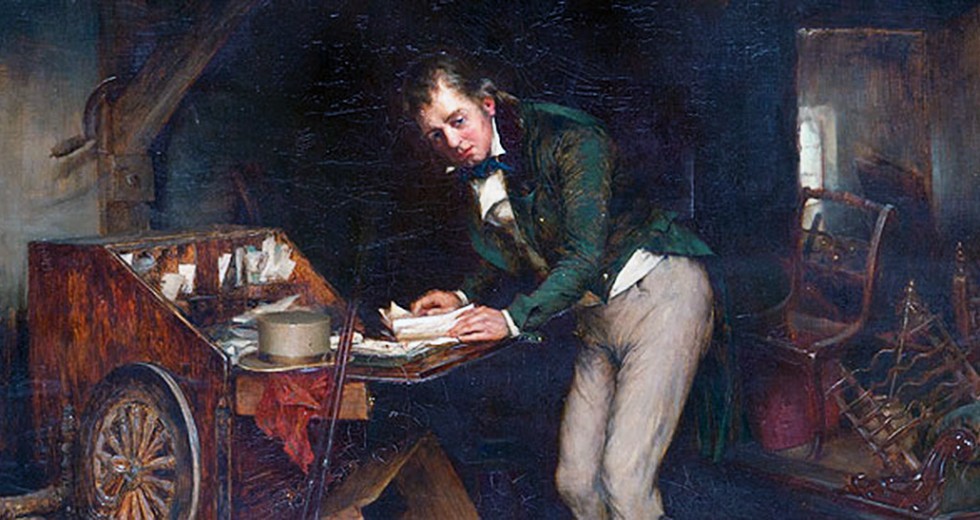
In February 1827, after Berlioz had already begun writing his Waverley Overture, Sir Walter Scott was publicly identified as the author of the highly popular “Waverley novels” — more than two dozen books, including Ivanhoe, Kenilworth, Rob-Roy, The Talisman and The Bride of Lammermoor (which Donizetti would use as the basis of his opera Lucia di Lammermoor in another eight years).
The publication of the first of these novels, Waverley, in 1814, was an immediate success; the first edition of 1,000 copies sold out in two days. The series continued to captivate the public throughout the 19th century. Few astute readers were fooled by Scott’s original decision to publish them anonymously. (Jane Austen caught on at once. In 1814, she wrote: “Walter Scott has no business to write novels, especially good ones. It is not fair. He has Fame and Profit enough as a Poet, and should not be taking the bread out of other people’s mouths. I do not like him, and do not mean to like Waverley if I can help it — but fear I must.”)
Berlioz, who discovered the novels in 1825, made a stab at a Waverley opera long before Donizetti, beginning Richard en Palestine, inspired by The Talisman, in 1826 and then abandoning it the next year. In his Memoirs, Berlioz says he began the Waverley Overture soon after Les francs-juges, the overture he composed sometime in 1826 (it’s the only remaining part of another unfinished opera).
Waverley was finished by February 1828, when arrangements for its performance were discussed, and it was premiered at Berlioz’s first concert at the Paris Conservatory on May 26. (Although it was an all-Berlioz program, the composer did not conduct.) Then just 24, Berlioz had not yet written any of the scores we regularly associate with him today, although he had recently met and fallen in love with Harriet Smithson, the actress who would inspire his first great blockbuster, the Symphonie fantastique of 1830.
Both the manuscript and the printed score — the overture was published in 1839 — are prefaced by a citation from Scott:
Dream of love and Lady’s charms
Give place to honour and to arms.
The music is in two parts, compatible with the spirit of the two lines of the inscription. a slow introduction with a tender theme, followed by a fiery allegro. The opening is particularly individual, with its oboe melody slipping in quietly and then continuing decrescendo. There are many highly imaginative touches in the instrumentation; Berlioz’s exceptional command of writing for the orchestra was there from the start, even as it grew more masterly in the works to come. The allegro is thrilling in a wild, unbuttoned way, and today it recalls episodes from several of the more familiar Berlioz scores.
In later years, after Berlioz was on his way to becoming the Berlioz of legend and lore, he dismissed the Waverley Overture as an indiscretion of his youth. Apparently he conducted it just once, in Hanover in May 1843. In fact, as Berlioz produced one sensational score after another in the 1830s and 1840s — the Symphonie fantastique was soon followed by Harold in Italy, the Requiem, and Romeo and Juliet — the Waverley Overture all but disappeared from concert programs.
In 1848, Berlioz claimed that it had been at least 15 years since he had last heard it and asked that it be removed from a projected concert program he was scheduled to conduct in England, since “it could be damaging for me, especially at a time when I am barely beginning to make myself known in London.”
The Waverly Overture is the last major work Berlioz wrote before he discovered the music of Beethoven, the single greatest artistic influence on his career. His subsequent works show how dramatically Berlioz was shaken by that experience, and how much his singular language benefitted from the sophistication and technical skill he found in Beethoven’s writing. But it is through the earliest works of any artist that we are able to glimpse their raw talent and sometimes find an astonishing kind of untutored creativity. The Waverley Overture is, in fact, our finest example of the pure genius of the young Berlioz, a figure as promising and original as any in the history of music.